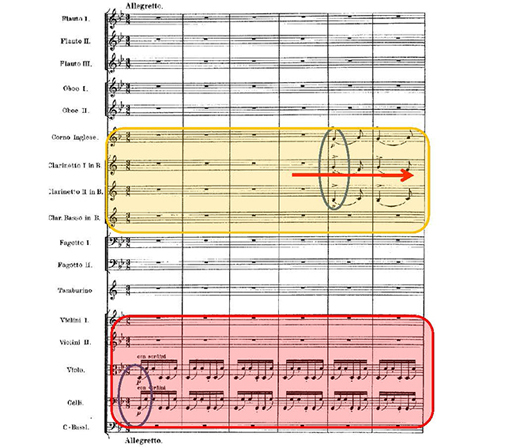4.1.4 Synthesising sight and sound

Hopefully, in studying the score of the Arabian dance you looked for rests, dynamic markings, layering of textures and repeating patterns. If you were conducting a ballet, you would also need to pay careful attention to rhythm patterns and speed.
Activity 1
Different elements of the music are outlined in Figure 5. Take some coloured pencils and mark these elements up as if you were a conductor, perhaps identifying the instrument groups with colours, marking instructions for dynamics with a specific colour (blue, for example, as seen in Figure 5), and marking the most important melody and any repetitions that you see with a different colour. The instrument groups are marked in the same colours as the diagram of the orchestral layout you saw earlier. You can see the first page of the score in Figure 5.
Discussion
A quick analysis of the score
Rather like the Schubert example we looked at last week, there are ‘layers’ in the score. The string parts at the bottom have lots of quick notes and the score looks quite black, but the clarinets and cor anglais are all moving together but at a slower pace.
There are a number of rests in the opening of the piece – the score looks quite ‘open’ – so expect to hear only a few instruments. You may also have noticed the dynamic marking, p.
We have looked at several melody and accompaniment textures in music by Mozart and Schubert where a slow-moving melody accompanies a variation with a lot of quick notes, or the accompaniment is formed by lots of quick notes. A similar technique is being used here. There is a slow-moving melody in the first clarinet part and the strings have a faster moving accompaniment. By bar 14, there is another layer, as the violins start playing the tune that the clarinets had, and the clarinets become another layer of accompaniment playing long slow notes. A new sound is introduced in bar 33, where the bassoons take the melody, but now the violins have rests, so the sound picture is darker with mostly low register instruments. Every now and then there is a ‘splash’ of tambourine.
The final section of this piece uses another technique that you have already come across in the Mozart variations. The melody is passed between the violins, clarinets and bassoons but in bar 69, a new melody is played by the oboe while the violins carry on playing the original tune. This new melody is a countermelody – literally a melody that plays against the melody.
